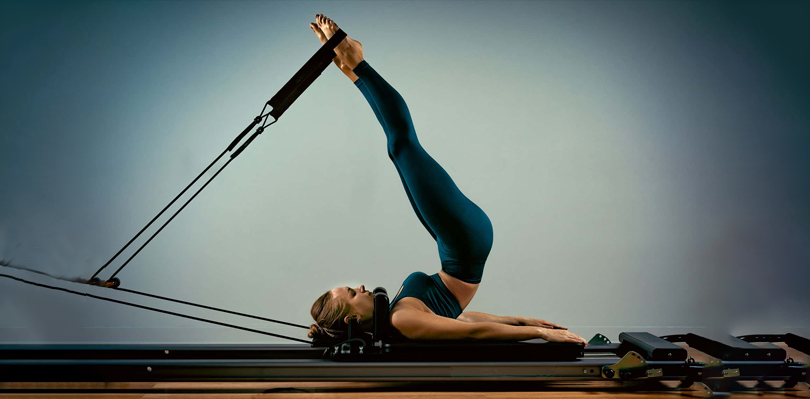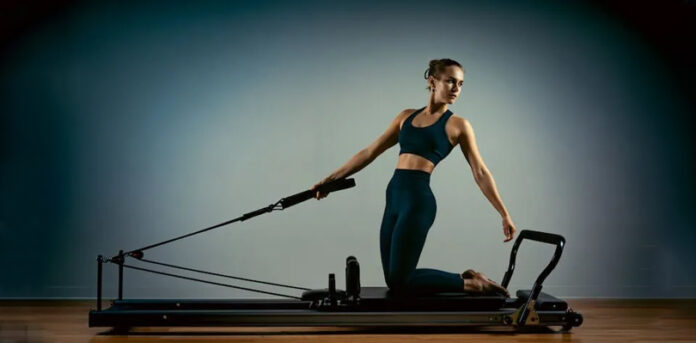Intermediate Pilates is suited for those practitioners who have mastered the basic Pilate exercises and are willing to further challenge their bodies. These level 2 Pilates are specially designed to strengthen your body, rectify your posture, and increase your overall body flexibility.
People often lack the knowledge of beginner and intermediate Pilates and thus fail to understand the importance of each. They also have no idea about how each Pilate level is designed and what each level aims at.
Considering all such queries, we have broken down everything here about intermediate and beginner Pilates. Let’s start with a brief difference between both levels.
What Is The Difference Between Beginner And Intermediate Pilates?

Beginner Pilates is suitable for everyone despite their experience. A beginner Pilate class is often controlled by an instructor who instructs using various Pilate machines. These sessions aim at providing a basic understanding of using the Pilate machines including Pilates reformer chair, barrel, hoops, and elastic bands.
These beginner Pilates sessions further help the practitioners learn how to transition between multiple exercises and equipment.
In a nutshell, beginner Pilate workouts cannot be performed without getting proper instructions from a Pilate expert.
On the other hand, intermediate Pilate also known as level 2 Pilates is an advanced level exercise that works on improving your core, flexibility, and strength. Although, beginner Pilate also works on your strength and flexibility intermediate Pilates is one level up as they challenge your body.
The pace of your workout increases as you level up while the need for instructions keeps declining. By the time you reach level 2 Pilates, you will be able to change your own equipment and transition between multiple exercises.
The main difference between beginner Pilates and Intermediate Pilates is, that beginner Pilates is suggested for those who are not aware of the basic knowledge of equipment. The pace of workouts remains slow and the practitioners at this stage also lack transition experience.
On the flip side, intermediate Pilates requires a higher pace and increased challenge and it also requires the practitioners to have a higher transition experience.
By the time a workout enthusiast reaches level 2 Pilate, he/she completely understands the equipment and positions and thus doesn’t require instructions at every stage.
Benefits Of Intermediate Pilates
From increasing athletic performance to building your mental well-being and balance, Pilates has multiple benefits. As you understand the basics of Pilates and reach level 2 Pilates, you are ready to increase your pace, and with increased pace, get ready to boast greater results.
Following are the major benefits you can reap:
- A Pilate workout routine helps improve your flexibility.
- It aids your muscular strength and tones up your abdominal muscles.
- It also improves the functioning of your lower back muscles, spine, hips, and abdominal muscles.
- It also helps stabilize your core and improve your posture.
- This workout routine is considered one of the most beneficial exercises for the safe rehabilitation of joint injuries.
- Fitness experts also claim that this exercise routine increases lung capacity and circulation.
- These workout sessions are also considered worthy for stress management and relaxation.
- As these exercise sessions involve deep breathing and concentration, they also play a vital role in improving bodily coordination and balance.
- Another prominent benefit of these workouts is, that they improve the overall flexibility of your body.
- It can also play a vital role in solving issues related to muscle imbalances.
- This exercise routine also helps in reducing back pain and other issues related to abdominal muscles.
Important Techniques
Pilates is being followed by millions of fitness enthusiasts from every corner of the world. They are suitable for everyone regardless of their fitness level, however as a beginner, one should seek expert guidance.
Whether you are trying to get rid of your backache, rectify your swayback postures, or build strength and flexibility, this workout can work wonders for you.
Before you start practicing, keep these expert-claimed techniques in your mind.
Focus On Your Breath
Although it might be a little challenging to coordinate with your breathing, listening to your breath can help you reap several benefits. Focus on your breathing patterns and observe how your body responds when you try to hold your breath.
Listen To Your Body
While practicing this exercise, be it the beginner level or intermediate phase, don’t overdo anything. Honor your body and never think of competing with anyone around you. Never exceed your limits instead, keep up a consistent pace.
Prefer Quality Over Quantity
Remember, Less is more! Spending a lot of time practicing wrong postures and exercises may lead you to injuries and they will be worthless. So, understand the moves, positions, and equipment well and prefer quality over quantity.
FAQs
What sets beginner and intermediate Pilates apart?
Beginner and intermediate Pilates differ in the level of challenge they provide. Beginner Pilates focuses on basic movements and core principles, making it perfect for those newbies. On the other hand, intermediate incorporates advanced exercises that require greater strength, balance, and coordination, making it more suitable for those who have already mastered the basics.
How do I transition from beginner to intermediate Pilates?
If you’re proficient in beginner Pilates exercises and are looking for more challenge, transitioning to intermediate Pilates is the way to go. Consult your instructor, pay attention to your body’s signals, and if basic exercises are no longer challenging you, then it’s probably time to progress.
What benefits come with advancing to intermediate?
Transitioning to intermediate Pilates brings many benefits, including enhanced core strength, flexibility, and body awareness. Advanced exercises improve muscle tone, balance, and stability, fostering a deeper mind-body connection and leading to greater physical and mental well-being.

